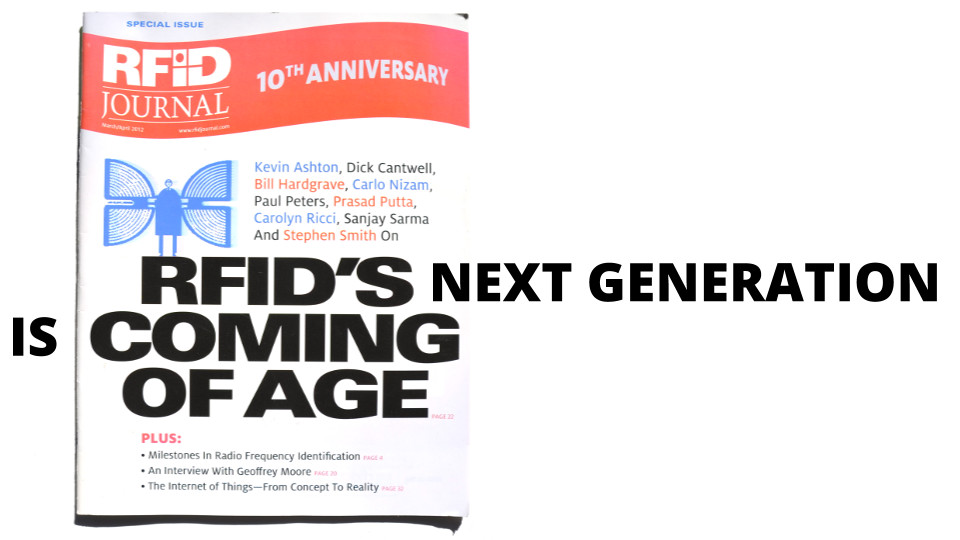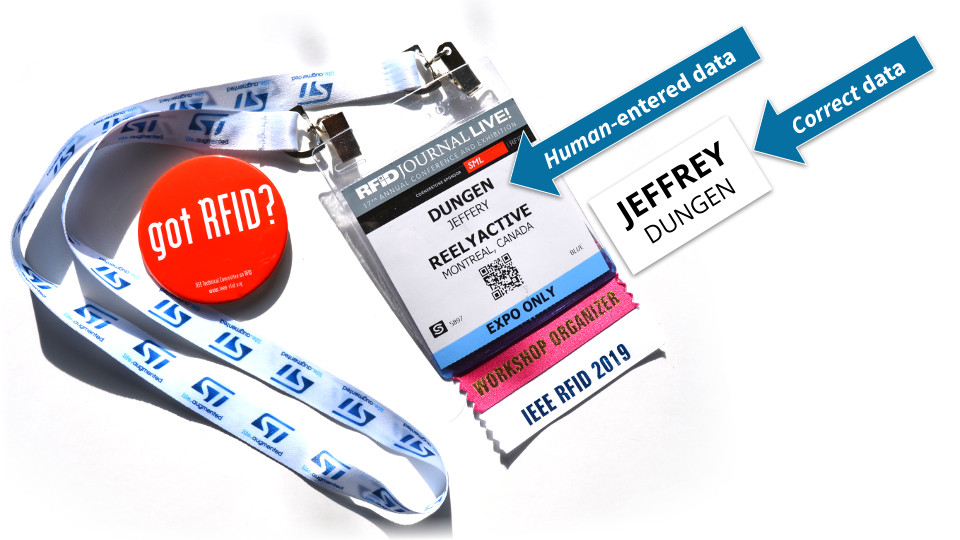Oh the irony of human-entered data at an RFID conference. Ten years ago, Kevin Ashton, who coined the term “Internet of Things”, explained in RFID Journal:
We need to empower computers with their own means of gathering information […] without the limitations of human-entered data.
Case in point, the badge: the surname and given name are reversed, with the latter mispelled misspelled as a result of human data entry during onsite registration from a paper & pencil form. Nonetheless, this is an excellent example for emphasising the potential of RFID and the IoT!
Indeed, at the co-hosted IEEE RFID event, I, Jeffery Jeffrey, presented a workshop entitled Co-located RFID Systems Unite! focused on this potential now that there are nearly 20 billion RAIN (passive) and BLE (active) units shipping annually. An open architecture for collecting, contextualising and distributing the resulting data is becoming critical, and I was pleased to hear this sentiment echoed on the RFID Journal side by Richard Haig of Herman Kay and Joachim Wilkens of C&A.
Also heard echoed was the prevalence of BLE (active RFID) throughout the conference. Literally.
This contraption which converts radio decodings into musical notes may seem odd at first, but over the past year we’ve learned that art is a powerful tool for conveying to a non-technical audience the prevalence and potential of RFID and IoT in our daily lives. A few attendees were invited to listen with headphones and walk around until they found a silent spot. None were successful.
And we can only expect such prevalence to increase with energy harvesting technology maturing. We were pleased to see Wiliot’s live demo of an energy harvesting BLE tag, making good on their objectives from last year’s conference. Inexpensive battery-free BLE will be key to RFID proliferating to all the physical spaces in which we live, work and play—the BLE receiver infrastructure is often already there.
Which came first: the RFID or the Digital Twin?
The concept of the Digital Twin has also taken off over the past year, and we were pleased to have the opportunity to ask Jürgen Hartmann which came first in the Mercedes-Benz car factory example he presented? His answer was clear:
“Without RFID, for us there is no Digital Twin.”
Ironically, our April Fool’s post from two days previous was about Digital Conjoined Twins where we joked that the digital twin resides in the optimal location: adjacent to the physical entity that it represents. Perhaps not so silly in the context of industrial applications highly sensitive to latency???
RFID projects championed by the organisation’s finance department?
That is exactly what Joachim Wilkens of C&A argued. The success of their retail RFID deployment was in direct consequence of the C-level being on board, but more importantly by having a business case championed by the finance department:
“This is not an IT project, this is a business project.”
While we’ve observed our fair share of tech-driven deployments over the past few years, we’re increasingly seeing measurable business outcomes. For instance, a recent workplace occupancy deployment delivered, within months, a 15% savings in real-estate. That is a business project—one the finance department would love to repeat!
IoT: the next generation
What will we discuss in our RFID Journal Live 2029 blog post when the IoT celebrates its third decade? That may well be in the hands of the next generation. Since we began attending the co-hosted IEEE RFID and RFID Journal Live in 2013, we’ve observed a slow but steady shift in demographics. A younger generation—one which grew up with the Internet—is succeeding the generation instrumental in the development and commercialisation of RFID. On the showroom floor, we’re talking about the Web and APIs. At the IEEE dinner we’re discussing industry-academia collaboration to teach students about applications and ethics. And in the IEEE workshops, ASU Prof. Katina Michael took the initiative to invite one of her undergraduate students to argue the (highly controversial) case for implantables, effectively ceding centre stage to the next generation.

The final print copy of RFID Journal we received back in 2012 is entitled “RFID’s Coming of Age”. Today I would argue that RFID’s next generation is coming of age. 1999 saw the emergence of the terms IoT and Web 2.0. Might we expect 2019 to mark the emergence of the term RFID 2.0?
